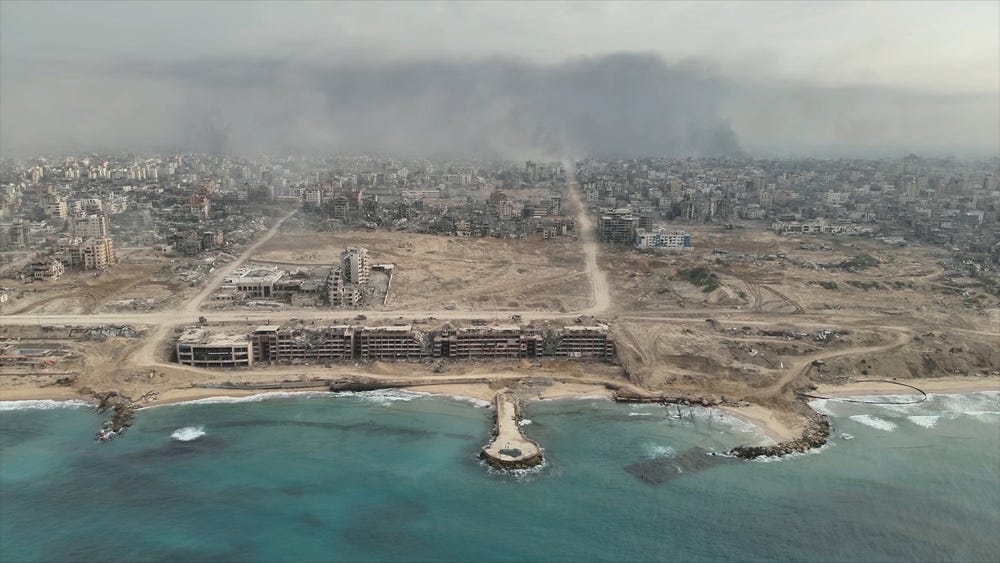The Gaza ceasefire is over. What’s next?
Much will depend on Trump, who retains significant leverage over Israel's Netanyahu.
Israel resumed military operations in Gaza this week.
In a rare show of bipartisan cooperation, the outgoing Biden administration worked closely with Donald Trump’s chief negotiator, Steve Witkoff, on a ceasefire between Israel and Hamas that took effect in the days leading up to Trump’s inauguration. As part of the agreement, Hamas agreed to—over the course of six weeks—release 25 hostages (including two Americans), five Thai nationals, and the bodies of eight Israelis killed during the Oct. 7, 2023, attacks (or subsequently in captivity). In exchange, Israel agreed to significantly ramp up the flow of humanitarian aid into Gaza and release hundreds of Palestinians held in Israeli jails, and to withdraw from certain strategic areas in Gaza.
Critical to the ceasefire was an agreement to begin negotiations on “Phase II” 16 days into the first phase. Phase II would lead to an agreement on transitional governing, security, and humanitarian/reconstruction of Gaza. That negotiation was always going to be incredibly hard, and the expectation was that Hamas would have to step back from governing Gaza and eventually disarm. The chances of achieving that agreement in such a limited time were exceedingly low, but at least if the two parties had begun engaging on these issues, it would have been much easier to extend the ceasefire, get more hostages out and aid in, and keep positive momentum going.
The ceasefire largely held in the first 42 days. There were violations on the edges and grotesque public displays by Hamas as it released Israeli prisoners—an effort to signal that it was still in full control of Gaza. However, the biggest challenge was that Israeli Prime Minister Benjamin Netanyahu had refused to engage seriously on Phase II. Why? Because any realistic talk about “the day after” in Gaza, must involve some element of Palestinian self-rule—a concept that is anathema to Netanyahu’s far right-wing allies, Itamar Ben Gvir and Belazal Smotrich. Ben Gvir had already left the governing coalition over the first ceasefire, and Smotrich said he would leave over any Phase II agreement—leading to a collapse of Netanyahu’s government. Netanyahu’s focus on staying in power instead of ending the conflict has been a problem since the start of the war and prevented him from engaging seriously on post-conflict planning—ultimately ensuring Israel’s failure to displace Hamas from Gaza. Now it has become a key reason for the restart of fighting.
Faced with these constraints, the Trump administration did something deeply destructive. In early February, with Netanyahu at the White House, Trump proposed a new, entirely unrealistic and amoral plan to remove more than 2 million Palestinians from Gaza and rebuild it. That plan has been met with universal opposition from Palestinians, the Arab world and other countries—all of whom rejected hosting huge numbers of Palestinians. But it did something even more damaging. It moved the Overton window in Israel, creating an expectation in large swaths of the Israeli public—especially Netanyahu’s base—that the idea of expelling Palestinians from Gaza was realistic, making it harder to agree to an alternative.
With time running out on the ceasefire, Witkoff then made a very reasonable play to ask both sides to extend the ceasefire, with more hostages and prisoners exchanged, more aid, and the start of Phase II. Israel agreed. Unsurprisingly, Hamas did not. It should go without saying Hamas should immediately release all hostages (and never should have taken them). However, after Netanyahu reneged on a critical aspect of the agreement, Hamas chose not to continue.
With that, the ceasefire expired more than two weeks ago. Rather than restart fighting, Israel chose to apply more pressure on Hamas—cutting off all international aid and turning off the electricity to a desalination plant that provided water to hundreds of thousands of Gazans. This tactic of collective punishment against Gaza’s civilian population was opposed by the Biden administration going back to the very first days of the war. Biden’s opposition was essential to mitigating what would have been an even worse humanitarian situation in Gaza. However, Trump, in contradiction to American values, supports it.
Netanyahu faced a March 31 deadline for his government to pass a new budget or go to elections. With Ben Gvir out of the government, Netanyahu held only a very narrow majority in the Knesset—one that might not have survived the next two weeks.
So, Israel on Tuesday announced it was restarting an air campaign in Gaza. Already, we are seeing significant Palestinian casualties. Meanwhile, Ben Gvir has reentered the government, stabilizing Netanyahu’s coalition. And the Trump administration continues to blame Hamas and give Israel a green light.
Netanyahu’s rationale is that this is the way to get the hostages out. But family members of hostages—including Yarden Bibas, whose wife and two young children were killed by Hamas, and the parents of American Omer Neutra—are entirely against this move, saying it only endangers the remaining hostages. These voices are critical now, especially for the hundreds of thousands who have taken to the streets in Israel.
Where do we go from here? Much will depend on Trump, who retains significant leverage over Netanyahu.
The best scenario is that this is a short and temporary flare of violence. If Netanyahu gets his budget passed at the end of the month, he might become more flexible. Hamas, under pressure, might agree to more hostage releases. And Trump, wanting to be seen as a peacemaker, would press Netanyahu to stop.
The worse scenario at this point is that we’re in for a much longer war. Except this time, with the total backing from an American administration for a complete siege of Gaza, no restraint on the impact of Israeli strikes on Palestinian civilians, and a plan to displace millions of Palestinians from their homes, which, if it were ever actually executed, would transform Israel into a global pariah.
And all of this will be for naught. Because the result is likely to be somewhere in the middle of these two scenarios, and after all the horror and suffering on all sides, Hamas will still control Gaza, and we will be right back where we started.
Ilan Goldenberg served as Vice President Kamala Harris's Special Advisor on the Middle East and previously held positions at the Pentagon and State Department. He is the author of the Dialogue and Dissonance Substack.







>>"Biden’s opposition was essential to mitigating what would have been an even worse humanitarian situation in Gaza. However, Trump, in contradiction to American values, supports it."
There it is in a nutshell. President Biden provided food and water to the Gaza refugees and got no credit for it. Instead he was called "Genocide Joe" and the pro-Palestinian faction of the Dems boycotted Kamala and they were a big help to hand the election to Trump.
What's next? More ethnic cleansing with Trump supplying the ammunition to his buddy "Bibi" Netanyahu. When Gaza is cleared out, then Trump and Jared can build Mar-a-Gaza with lots of luxury condos for their rich friends.
'Netanyahu’s rationale is that this is the way to get the hostages out. But family members of hostages'. This is shameful. Netanyahu is a nazi, has been a nazi, orchestrating a genocide of biblical proportions. I am heartbroken to read this biased analysis here, on this platform,.Please pause to reflect on the tragedy of Palestine, which is in rubbles, with 50000 people killed in some 18 months, so many children and women - and one keeps talking of Hamas, as if this was a war between 2 armies. We speak od decades of apartheid, with Gaza being basically the world's largest concentration campo.
Here is an example of objective reporting, by a human being who feels solidarity and empathy: https://www.youtube.com/watch?v=Qfxam5Z_EHM